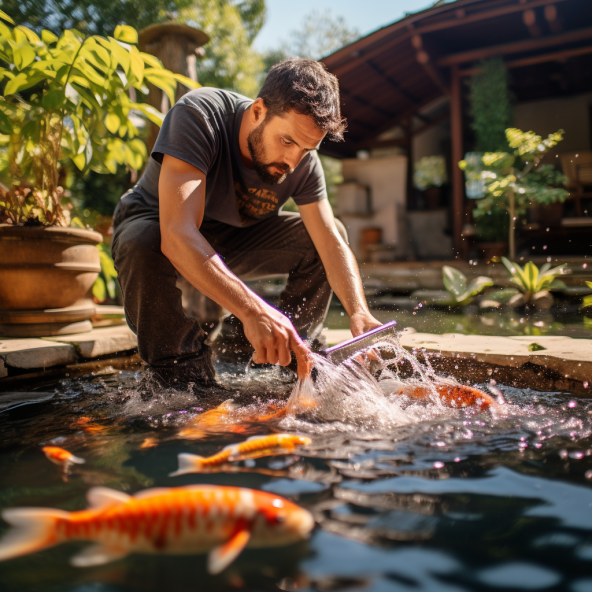A How-To Guide by Koi Enthusiast Mike Savage From His New Cannan Backyard
Having a tranquil koi pond filled with vibrant fish adds a touch of magic to any garden. But for beginners, the idea of building one might seem daunting. Fear not! With careful planning and this handy guide, you can create your own koi haven, even with limited experience.
Before You Dig Your Koi Pond
- Plan and permit: Sketch your desired pond size, shape, and depth. Consider local regulations and permits, as some areas require them for ponds exceeding a certain volume.
- Choose a location: Opt for a sunny spot with at least 6 hours of sunlight for healthy plant growth. Avoid trees with aggressive roots and underground utilities.
- Gather your tools: Shovel, wheelbarrow, liner, underlayment, pond skimmer, filter, pump, rocks, aquatic plants, etc. (specifics depend on your design).
Step-by-Step Koi Pond Construction
- Excavation: Mark the pond outline and start digging. Remember to create shelves for plants at different depths. Aim for a minimum depth of 3 feet to accommodate koi overwintering.
- Level and compact: Ensure the base is level and free of debris. Compact the soil firmly to prevent settling and liner damage.
- Underlayment: Line the entire excavation with a protective underlayment fabric to prevent punctures from rocks or roots.
- Liner installation: Spread the pond liner, ensuring it reaches all edges and shelves. Secure it with liner tape or rocks. Fill the pond partially with water to help smooth out wrinkles.
- Edges and filtration: Create a natural-looking edge by burying excess liner and adding rocks. Install the skimmer, filter, and pump as per their instructions, ensuring proper circulation and filtration.
- Water features: Add waterfalls, fountains, or bubblers for added aeration and visual appeal.
- Planting: Choose aquatic plants suitable for your pond depth and sunlight levels. They provide fish hiding spots, improve water quality, and add oxygen.
- Filling and testing: Slowly fill the pond with water and monitor water quality using a test kit. Adjust filtration or add water conditioners as needed.
- Cycling: Let the pond filter cycle for several weeks before introducing fish. This allows beneficial bacteria to establish and maintain water quality.
Koi Pond Care
- Research koi needs: Understand their water quality requirements, feeding and nutrition habits of the koi, and potential health issues.
- Start small: Begin with a few young koi and gradually increase the number as your pond matures.
- Maintain water quality: Regularly test and adjust water parameters like pH, ammonia, and nitrite. Perform partial water changes as needed. Also master the art of how to clean a koi pond.
- Feed properly: Choose high-quality koi food and avoid overfeeding, which can harm water quality.
- Enjoy your oasis! Sit back, relax, and watch your koi thrive in their new aquatic home.
Conclusion
- This is a simplified guide. Adapt it to your specific pond design and consult professionals for complex setups.
- Safety first! Wear gloves and proper footwear during construction. Be mindful of electrical hazards near water features.
- Patience is key! Building and maintaining a healthy koi pond takes time and dedication.
With careful planning and this guide, you can create your own stunning DIY koi pond that becomes a cherished feature of your garden and a source of joy for years to come.
ABOUT MIKE SAVAGE OF NEW CANAAN, CT
Michael Savage from New Canaan is the Founder of 1-800 Accountant that helps businesses with their accounting services and needs through cutting-edge technology and customer support.
In his spare time, Savage enjoys collecting Michael Jordan sneakers, vintage Lego sets, and admiring muscle cars and unique pop art. He and his wife also spearhead the Savage-Rivera foundation to help impoverished families in Honduras.

